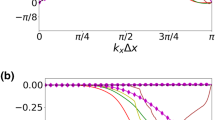Abstract
A second-order optimized monotonicity-preserving MUSCL scheme (OMUSCL2) is developed based on the dispersion and dissipation optimization and monotonicity-preserving technique. The new scheme (OMUSCL2) is simple in expression and is easy for use in CFD codes. Compared with the original second-order or third-order MUSCL scheme, the new scheme shows nearly the same CPU cost and higher resolution to shockwaves and small-scale waves. This new scheme has been tested through a set of one-dimensional and two-dimensional tests, including the Shu-Osher problem, the Sod problem, the Lax problem, the two-dimensional double Mach reflection and the RAE2822 transonic airfoil test. All numerical tests show that, compared with the original MUSCL schemes, the new scheme causes fewer dispersion and dissipation errors and produces higher resolution.
Similar content being viewed by others
References
Harten A. High resolution schemes for hyperbolic conservation laws. J Comput Phys, 1983, 49: 357–393
Fu D X. Direct numerical simulation of compressible turbulence. Beijing: Science Press, 2010
Cada M, Torrilhon M. Compact third-order limiter functions for finite volume methods. J Comput Phys, 2009, 228: 4118–4145
Sweby P K. High resolution schemes using flux limiters for hyperbolic conservation laws. SIAM J Numer Anal, 1984, 21: 995–1011
Van Leer B. Towards the ultimate conservation difference scheme V. A second-order sequel to Godunov’s Method. J Comput Phys, 1979, 32: 101–136
Harten A, Engquist B, Osher S, et al. Uniformly high order accurate essentially non-oscillatory shock-capturing schemes III. J Comput Phys, 1987, 71: 231–303
Serna S, Marquina A. Power ENO methods: A fifth-order accurate weighted power ENO method. J Comput Phys, 2004, 194: 632–658
Jiang G S, Shu C W. Efficient implementation of weighted ENO schemes. J Comput Phys, 1996, 126: 202–228
Shu C W. TVB uniformly high-order schemes for conservation laws. Math Comput, 1987, 49: 105–121
Suresh A, Huynh H T. Accurate monotonicity-preserving schemes with Runge-Kutta time stepping. J Comput Phys, 1997, 136: 83–99
Christopher K W T, Webb J C. Dispersion-relation-preserving finite difference schemes for computational acoustics. J Comput Phys, 1993, 107(2): 262–281
Lele S K. Compact finite difference schemes with spectral-like resolution. J Comput Phys, 1992, 103: 16–42
Shu C W, Osher S. Efficient implementation of essentially non-oscillatory schemes. J Comput Phys, 1989, 83: 32–78
Godunov C K. Difference method for computing the discontinuity in fluid dynamics. SB Math+, 1959, 47(3): 271
Jennings G. Discrects shock. Comm Pore Appl Math. 1974, 27: 25–37
Fu D X, Ma Y W. Computational Fluid Dynamics (in Chinese). Beijing: High Education Press, 2002
He Z W, Li X L, Fu D X, et al. A 5th order monotonicity-preserving upwind compact difference scheme. Sci China-Phys Mech Astron, 2011, 54: 511–522
Daru V, Tenaud C. High order one-step monotonicity-preserving schemes for unsteady compressible flow calculations. J Comput Phys, 2004, 193: 563–594
Steger J L, Warming R F. Flux vector splitting of the inviscid gasdynamic equations with applications to finite difference methods. J Comput Phys, 1981, 40: 263–293
Van Leer B. Flux-vector Splitting for the Euler Equations. Technical Report ICASE 82–30, NASA Langley Research Center, USA, 1982
Roe P L. Approximate Riemann solvers, parameter vectors and difference schemes. J Comput Phys, 1981, 43: 357–372
Liou M S, Steffen J C J. A new flux splitting scheme. J Comput Phys, 1993, 107: 23–39
Kim K H, Lee J H, Rho O H. An improvement of AUSM schemes by introducing the pressure-based weight function. Comput Fluids, 1998, 27(3): 311–346
Kim K H, Lee J H, Rho O H. An improvement of AUSM schemes by introducing the pressure-based weight function. In: The Fifth Annual Conference of the Computational Fluid Dynamics Society of Canada (CFD 97), 1997. 5: 14-33–14-38
Shu C W, Dinshaw S B. Monotonicity preserving weighted essentially non-oscillatory schemes with increasingly high order of accuracy. J Comput Phys, 2000, 160: 405–452
Sod G A. A survey of several finite difference methods for system of non-linear hyperbolic conservation law. J Comput Phys, 1978, 21(1): 1–31
Shu C W. Essentially Non-Oscillatory and Weighted Essentially Non-Oscillatory Schemes for Hyperbolic Conservation Laws. NASA/CR-97-206253, ICASE Report, 1997: 65–97
Toro E F. Riemann Solvers and Numerical Methods for Fluid Dynamics. 2nd. Berlin: Springer, 1997
Woodward P, Colella P. The numerical simulation of two-dimens ional fluid flow with strong shocks. J Comput Phys, 1984, 54: 115–173
Cook P H, McDonal M A, Firmin M C P. Aerofoil RAE2822-Pressure Distributions, and Boundary Layer and Wake measurements. Experimental Data base for Computer Program Assessment, AGARD Report AR 138, 1979
Author information
Authors and Affiliations
Corresponding author
Rights and permissions
About this article
Cite this article
Leng, Y., Li, X., Fu, D. et al. Optimization of the MUSCL scheme by dispersion and dissipation. Sci. China Phys. Mech. Astron. 55, 844–853 (2012). https://doi.org/10.1007/s11433-012-4702-0
Received:
Accepted:
Published:
Issue Date:
DOI: https://doi.org/10.1007/s11433-012-4702-0




